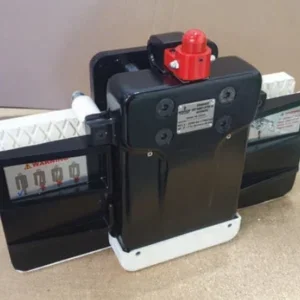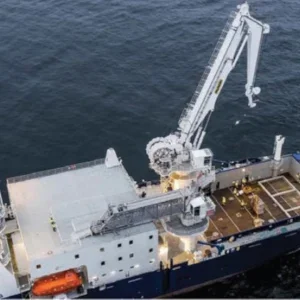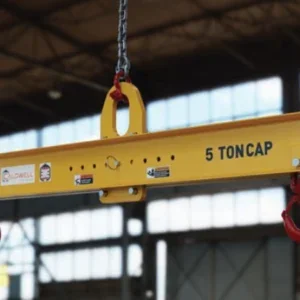The International Standard ISO 12482, which covers crane condition monitoring, gives (in Annex A) some provisions for assessment of a crane’s remaining life. The standard is now used in practice. Different safety factors are to be used in accordance with the way the information of the crane’s working conditions is collected. If these conditions are recorded by a special instrument, the safety factor is taken as equal to 1.0. In other words, the results of recordings are taken as read. All known approaches for the collection, interpretation and representation of working conditions are not perfect as they do not give parameters comparable with those which are now accepted to determine design life-time of cranes.
A new approach for estimation of a crane’s remaining safety life is proposed. The approach is entirely based on International Standard ISO 4301-1 1986 Cranes and lifting appliances – Classification – Part 1: General. It can be implemented in practice by all crane microprocessor-based logging systems. This approach will assist crane users and experts on maintenance to plan their work more accurately. It will also be useful for those who are to assess the risks of safety loss in crane operation.
It is shown how technical personnel can achieve in practice a realistic estimation of the remaining safety life of a crane on the basis of the new approach.
Significance of life expectancy
Because cranes lift large objects and move them through the air, the use of cranes always entails risks. The most essential class of risks is loss of crane reliability in operation. These risks unavoidably increase over time due to ageing of the crane. When the designer estimates expected crane safety life, he accepts to some extent a reasonable and allowable level of risk at the final stage of the crane’s use. If the crane’s safety life is depleted, further operation of the crane can lead to an increase of the risks beyond the allowable limits and may become unpredictable. For this reason it is important to be able to realistically estimate the remaining safety life of the crane.
The problem under consideration is in two parts, to be solved separately. The first is represented by the expected safety life of a crane, to be ensured by the designer and/or manufacturer. The second part is represented by the remaining safety life (remaining resource) of a crane, which is to be measured or calculated by a user at any moment of the crane’s operation.
It is known that expected crane safety life is defined by a crane classification group in accordance with International Standard ISO 4301-1 1986. In this standard the crane safety life of any classification group is determined with the help of the maximum number of operating cycles, which the crane is to fulfill at some spectrum of lifted loads.
At present the classification has in practice only two applications. Firstly the purchaser and the manufacturer of a crane. Agreement is necessary between them on the duty of the crane and to apply it. The classification thus agreed constitutes the overall classification of the crane as a whole; it is intended for contractual and technical reference purposes. The second application of the classification is to provide a basis for the crane designer to build up his analysis of the design and to verify that the crane is capable of achieving the desired life under the estimated conditions of service specified for the particular duty. As a person skilled in crane technology, the designer takes the estimated number of operating cycles and load spectrum data, either provided by the purchaser or predetermined by the manufacturer (as is the case in the design of serially produced equipment), and incorporates them into the assumption on which his analysis is based, while considering all other factors which influence the proportioning of components.
The crane designer makes the necessary calculations and tests which verify and confirm the desired intentions. But during the crane’s operation we need to see after the depletion of its safety life (resource). Thus we go to the second part of the problem outlined above.
There are known procedures to measure crane resource depletion. For instance, two of them are described in FEM 9.755. The first is based on measuring working time, and the other on measuring the spectrum of lifted loads. These procedures, however, do not give parameters directly comparable with those which are used for determining classification groups. The author considers, therefore, that those mentioned and all other procedures so far existing are not perfect. A new measurable criterion is offered below for estimating the remaining resource of the crane at any time.
Basic relationships
The classification of a crane as a whole is determined in accordance with ISO 4301-1 from Table 1. It can be seen from this table that two factors define eight groups. Any crane pertains to one of them. One factor is the state of loading, expressed by nominal load spectrum factor Kp, and the other is the class of utilisation, expressed by the maximum number of operating cycles. It can also be seen that all identical groups are arranged along diagonals, meaning that actually only one factor can define any group. This dimensionless factor, which denominated here as “nominal characteristic number of the crane”, is equal to
Ncr.n = Kpi x Cl = const
where i is an index of nominal load spectrum factor and l is an index of a maximum number of operating cycles (as in Table 1). The nominal value of Ncr.n for each group classification is given in
Table 2.
To determine the current value of the remaining safety life of a crane at any moment of its operation we should measure or compute a difference between Ncr.n and the current value of Ncr.t for any instant of time t.
Let us rearrange the above formula, taking into account expressions for Kpi, and Cj given in ISO 4301-1:
where Cj represents the average number of load cycles which occur at the individual load levels: C1, C2, C3…Cn;
CT is the total of all the individual load cycles at all load levels,
CT = sCj = C1+C2+C3+…+Cn ;
Pj represents the individual load magnitudes (load levels) characteristic of the duty of the crane: P1, P2, P3…Pn ;
and Pmax is the heaviest load that may be handled by the crane, i.e. rated load.
It is easy to see that this formula can also be used for calculation Ncr.t. To do it we are to measure the mass Pj of a lifted load in every load cycle and substitute it and the known Pmax in the formula. But it is more convenient for processing measurements to sum them individually without ranging load cycles in accordance with load levels. The above formula may therefore be rewritten as:
where Ct represents the number of operating cycles carried out by crane towards time t.
For the purposes of classification it was agreed that an operating cycle commences when a load is ready for hoisting and ends at the moment when the crane is ready to hoist the next load, i.e. independently of the individual content of the operating cycle. The above formulae, therefore, are entirely in accordance with ISO 4301-1. For the purpose of practicability it is rational to consider a commencement of a cycle when the load for instance strains ropes to 5% of the strain made by the rated load.
An analogous algorithm may be proposed for the estimation of the remaining life of crane mechanisms and hoists but there are some specifics of the applied procedures. Group classification of mechanisms is shown in Table 3.
In this case, as well, two factors determine the group to which a mechanism or hoist belongs. One factor is the state of loading, expressed by nominal load spectrum factor Km, and the other is the utilisation class, expressed by the total duration of the mechanism’s use. It can also be seen from Table 3 that all identical groups are arranged along diagonals. It means that one factor may determine any group. This factor, which may be named “mechanism characteristic number”, is equal to
Nm.n = Kmi x Tl = const
where i is an index of the nominal load spectrum factor, and l is an index of a utilisation class (as in Table 3, below).
The nominal values of Nm.n for each group classification are given in Table 4.
The current value of Nm.t may be calculated in accordance with the formula where tn represents the duration of use of the mechanism at the individual load level Pn;
Pn represents the individual loading magnitudes P1, P2, P3…Pn (loading levels) characteristic of the duty of the mechanism;
Pmax is the greatest loading magnitude applied to the mechanism;
and n is the number of the load levels taken into account.
Values of tn and Pn are to be measured and substituted in Formula 4(5?) for calculation.
Analysis of basic relationships
The factor Ncr.n given in Table 2 may be interpreted as a measure of nominal volume of work, which a crane of specified classification group is to fulfil during its safety life. This factor is similar to the rated mileage that a car is intended to run during its safety life. Hence factor Ncr.n is the only sufficient (adequate) characteristic for the term of the crane safety service life.
The factor Nm.n given in Table 4 may be interpreted in a similar way as a measure of the nominal volume of work, which a mechanism of a specified group of classification is to fulfil during its safety life. It should be noted here that Nm.n is given in hours, whereas Ncr.n is a dimensionless value.
It is useful to note that every summand is a particle of the crane’s safety life, which is spent for one operating cycle carried out by the crane. Similar note may be made from analysis of formulae regarding crane mechanisms.
Practical applications
Every crane in use is to be equipped with a rated capacity limiter or rated capacity indicator. Most modern rated capacity limiters and indicators have microprocessors and incorporate a logging function. They can easily measure and process measured data, if programmed, to get at least the value of Ncr.t at any time.
Furthermore, new directions in the development of safety devices comprise new generations of load monitoring systems (such as the PAT DL 350 crane logger, among others). These systems can log data regarding various parameters of crane operation. They can also be programmed for estimation of Ncr.t in accordance with the proposed algorithm.
The Russian-made rated capacity limiter ONK-140-M does not have a very powerful microprocessor (its memory has only 256kB). But, among other things, it does allow the measurement of loads, calculation of Ncr.t, and determination of the moments in time, as functions of Ncr.t, when various works of maintenance should be carried out. These data may build up a solid basis for creating optimised maintenance systems.
In Figure 1 (right) a functional connection is shown between a curve Ncr measured on a mobile crane and t. The safety life of the crane T may be found as the point of intersection of a curve Ncr.t and a straight line Ncr.n.
Ncr.t1, Ncr.t2 and Ncr.t3 are values of Ncr.t when various procedures of maintenance should be carried out. All Ncr.ti intervals are equal. As it can be seen, corresponding time intervals t1, t2 and t3 are not equal.
This example demonstrates that maintenance procedures planned in accordance with certain moments of time, and in accordance with values of Ncr.t in general cases, are not equivalent.
Obviously more optimal planning of maintenance will be the case when it is made in accordance with values of Ncr.t. Again it is similar with maintenance planning for automobiles, which is being made in accordance with mileages. Hence, technical experts should plan their optimised crane maintenance systems on the basis of fulfilled volumes of crane work adequately described by values of Ncr.
The remaining life of a crane can be found as the difference between the current value of time and T.






